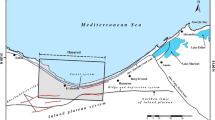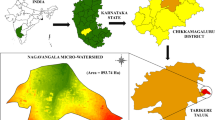Abstract
This paper discusses the methods and process of Geographic Information System (GIS) applied in soil spatial analysis, involving the collection of soil spatial data that GIS required, spatial analysis method of soil nutrient, land use, slope and exposure of geography, crop yield and other factors, and also including acquiring soil spatial information and creating thematic map, and so on. Taking Hengjing Town in Wuxian County of Jiangsu Province as a case study and the maximum income as a principle, and applying the GIS methods and their interrelated models, we have calculated the most optimized agricultural land and the possible maximum income of Hengjing Town. According to the method, we can rationally regulate local agricultural production, and put forward some scenarios for optimizing agricultural structure of Hengjing Town. The paper puts forward an evaluation method of land adaptability based on soil spatial analysis, and offers some research clews to optimize agricultural land use constitution, so the paper will be have important reference value for soil study.
Similar content being viewed by others
References
DE Roo, WESSELING A P J, RITSEMAN C J, 1996. LISEM: A single-event physically based hydrological and soil erosion model for drainage basins I: theory, input and output [J]. Hydrological Processes, 10: 1107–1118.
EVANS J K, GOTTGENS J F, 2000. Sediment yields controlled by intrabasinal storage and sediment conveyance over the interval 1842–1994, Chagrin River, Northeast Ohio, U. S. A [J]. Journal of Soil and Water Conservation, 55(3): 264–270.
GAO Jun-feng, LI Hu, 2002. Designing methodology of optimization system for agriculture landuse[J]. Agro-environmental Protection, 21(2): 122–125. (in Chinese)
GAO Jun-feng, CAO Hui, 2002. Spatail analysis of soil using GIS [J]. Soil, 34(4): 206–209. (in Chinese)
MENG F R, BOURQUE C P A, JEWETT K et al., 1995. The Nashwaak experimental watershed project: analyzing effects of clear cutting on soil temperature, soil moisture, snow pack, snowmelt and stream flow, Boreal forests and global change[J]. Water, Air and Soil Pollution, 82(2): 363–374.
ROSSITER D, ALES G, 1990. A framework for land evaluation using a micro-computer [J]. Soil Use and Management, 6: 7–20.
VAN Engelen, SOTER V W P, 1999. The world soil and terrain database [A]. In: SUMMER E M (ed.). Handbook of Soil Science [C]. Boca Raton: CRC Press, H19-H28
WAGNER B, TARNAWSKI V R, WESSOLEK G et al., 1998. Suitability of models for the estimation of hydraulic parameter [J]. Geoderma, 86: 229–239.
ZHAO Qi-guo, 2001. Prospects of soil science in the 21st century [J]. Advance in Earth Science, 16(5): 704–709. (in Chinese)
Author information
Authors and Affiliations
Additional information
Foundation item: Under the auspices of the Knowledge Innovation Project of the Chinese Academy of Sciences (No. KZCX1-SW-12-1-2, CXNIGLAS-A02-011, KZCX2-311).
Biography: GAO Jun-feng (1967 –), male, a native of Erdos City of Inner Mongolia Autonomous Region, associate professor, specialied in digital catchment and modeling. E-mail: gaojunf@niglas.ac.cn.
Rights and permissions
About this article
Cite this article
Gao, Jf., Li, Cf. & Zhang, Hh. Soil spatial analysis and agricultural land use optimization by using GIS. Chin. Geograph.Sc. 13, 25–29 (2003). https://doi.org/10.1007/s11769-003-0080-x
Received:
Issue Date:
DOI: https://doi.org/10.1007/s11769-003-0080-x




